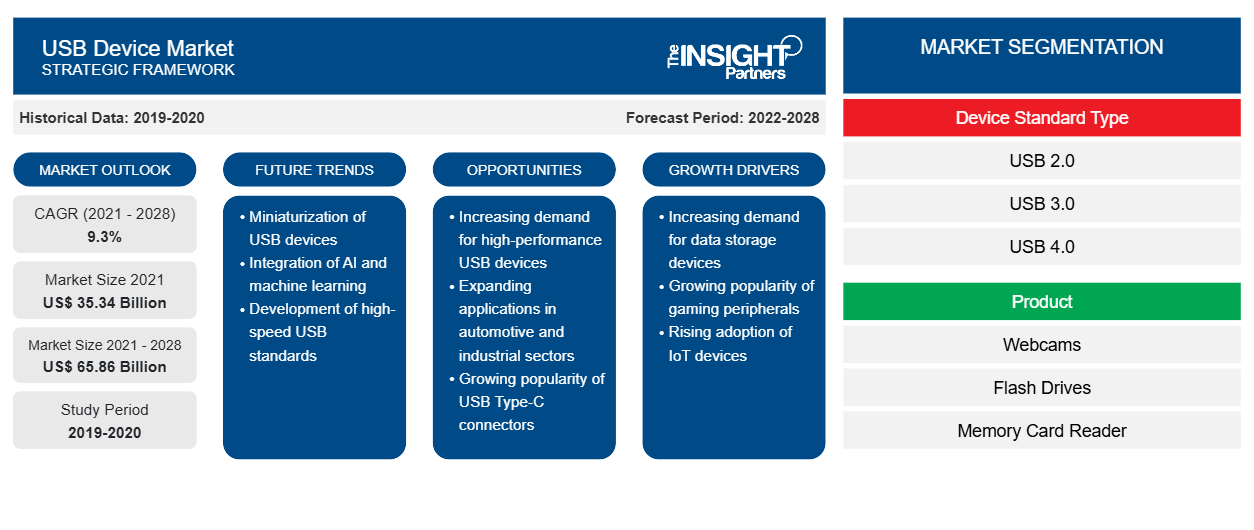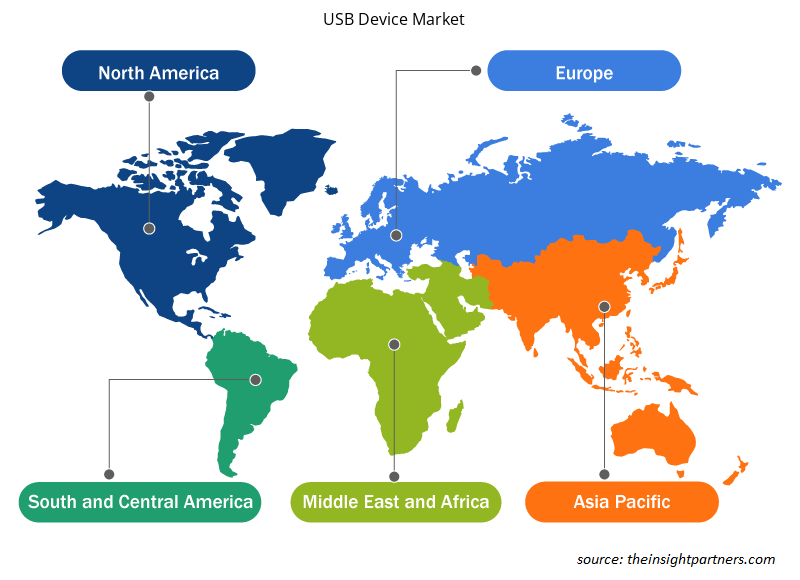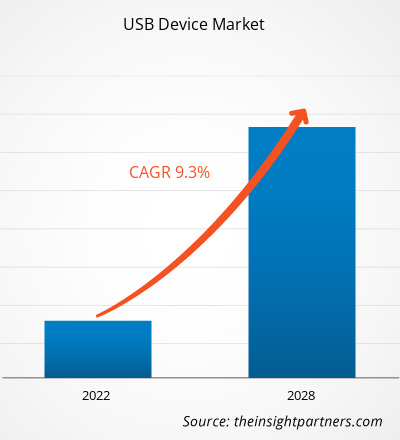The USB device market was valued at US$ 35,339.3 million in 2021 and is projected to reach US$ 65,857.2 million by 2028; it is estimated to register a CAGR of 9.3% from 2021 to 2028.
The increasing use of consumer electronics such as smartphones and laptops in developed and developing countries is mainly attributed to rising disposable income, increasing population, and growing Internet penetration. The ongoing significant technological developments have led to a rise in the penetration of these devices across several economies. In 2020, as per the Consumer Technology Association (CTA), sales of smartphones in the US accounted for 152 million units. USB devices have become a dominant interface to address growing requirements for swift data transfer between end devices, such as laptops, smartphones, PCs, and digital cameras. Thus, with the escalating demand for consumer electronics and data transmission products, the global USB devices market players focus on launching new products to achieve sustainable growth and distinguish themselves from their competitors, thereby contributing to the market growth.
Customize This Report To Suit Your Requirement
You will get customization on any report - free of charge - including parts of this report, or country-level analysis, Excel Data pack, as well as avail great offers and discounts for start-ups & universities
USB Device Market: Strategic Insights

- Get Top Key Market Trends of this report.This FREE sample will include data analysis, ranging from market trends to estimates and forecasts.
You will get customization on any report - free of charge - including parts of this report, or country-level analysis, Excel Data pack, as well as avail great offers and discounts for start-ups & universities
USB Device Market: Strategic Insights

- Get Top Key Market Trends of this report.This FREE sample will include data analysis, ranging from market trends to estimates and forecasts.
Impact of COVID-19 Pandemic on USB Device Market
The COVID-19 hampered the adoption of USB devices worldwide in 2020 as sales of industries such as electronics and automotive were hampered due to the impact on supply lines. Meanwhile, the adoption of USB devices across IT & telecom and healthcare was reported on the higher side owing to the high emphasis on remote working and remote learning practices following a rise in the number of patients across hospitals due to COVID-19. However, from Q1 of 2021, the supply lines of the automotive and electronics industry started to stabilize, and revenue of these industries showcased positive momentum, which subsequently propelled the USB devices market.
Market Insights – USB Device Market
Surging Adoption of USB Type-C in Medical Industry
The growing technological advancements in USB Type-C are likely to increase its scope in the medical industry. Prominent players are highly designing next-generation USB devices to stay ahead in the competitive market. For instance, TE Connectivity launched its onboard USB Type-C receptacle connector; it is a waterproof device that protects systems in severe environments with IPX8 (waterproof rating) dust and water ingression performance. With the given waterproof rating, the USB Type-C connector maintains a continuous connection at a water depth of 1.5 m for a minimum of 30 minutes. Further, the growing aging demographics, combined with increasing demand for early-stage diagnosis of chronic diseases, is boosting the demand for medical imaging equipment worldwide, thereby boosting the demand for next-generation USB Type-C devices. Thus, such a rise in the use of USB Type-C systems, especially in the medical device manufacturing industry, is likely to provide growth opportunities to the USB device market players in the coming years.
Application-Based Insights
Based on type, the USB device market is segmented into consumer electronics, automotive, IT & telecommunication, and healthcare and medical devices. The IT & telecommunication segment is likely to hold the largest market share in 2021.
Players operating in the USB device market are mainly focused on the development of advanced and efficient products.
- In October 2021, SK hynix Inc. announced its launch of the first DDR5 DRAM. It is a high-speed and high-density product optimized for big data, artificial intelligence (AI), and machine learning (ML) as a next-generation standard of DRAM.
- In August 2021, Analog Devices, Inc. announced the acquisition of Maxim Integrated Products, Inc. The combination further strengthens ADI’s position as a high-performance analog semiconductor company with trailing 12-month revenue of over US$ 9 billion, industry-leading margins, and free cash flow of over US$3 billion on a pro forma basis.
The USB device market is segmented into device standard type, product, connector type, application, and geography. Based on the device standard type, the market is segmented into USB 2.0, USB 3.0, and USB 4.0. In 2021, the USB 3.0 segment is likely to hold the largest market share. Based on the product, the USB device market is segmented into webcams, flash drives, memory card readers, digital audio players, computer peripherals, and others. In 2021, the computer peripherals segment is likely to hold the largest market share. Based on connector type, the USB device market is segmented into Type A, Type B, Type C, and lightning connector. In 2021, the type B segment is likely to hold the largest market share. Based on application, the market is segmented into consumer electronics, IT and telecommunications, automotive, healthcare and medical devices, and others. In 2021, the IT & telecom segment is likely to hold the largest market share. Geographically, the market is broadly segmented into North America, Europe, Asia Pacific (APAC), the Middle East & Africa (MEA), and South America (SAM). In 2021, North America accounted for a significant share of the global market.
USB Device Market Regional Insights
The regional trends and factors influencing the USB Device Market throughout the forecast period have been thoroughly explained by the analysts at The Insight Partners. This section also discusses USB Device Market segments and geography across North America, Europe, Asia Pacific, Middle East and Africa, and South and Central America.

- Get the Regional Specific Data for USB Device Market
USB Device Market Report Scope
| Report Attribute | Details |
|---|---|
| Market size in 2021 | US$ 35.34 Billion |
| Market Size by 2028 | US$ 65.86 Billion |
| Global CAGR (2021 - 2028) | 9.3% |
| Historical Data | 2019-2020 |
| Forecast period | 2022-2028 |
| Segments Covered |
By Device Standard Type
|
| Regions and Countries Covered | North America
|
| Market leaders and key company profiles |
USB Device Market Players Density: Understanding Its Impact on Business Dynamics
The USB Device Market is growing rapidly, driven by increasing end-user demand due to factors such as evolving consumer preferences, technological advancements, and greater awareness of the product's benefits. As demand rises, businesses are expanding their offerings, innovating to meet consumer needs, and capitalizing on emerging trends, which further fuels market growth.
Market players density refers to the distribution of firms or companies operating within a particular market or industry. It indicates how many competitors (market players) are present in a given market space relative to its size or total market value.
Major Companies operating in the USB Device Market are:
- ADATA Technology Co., Ltd
- Corsair
- Imation Corporation
- Kingston Technology Corporation
- Samsung Corporation
Disclaimer: The companies listed above are not ranked in any particular order.

- Get the USB Device Market top key players overview
USB Device Market – Company Profiles
- ADATA Technology Co., Ltd
- Corsair
- Imation Corporation
- Kingston Technology Corporation
- Samsung Corporation
- SanDisk Corporation
- Toshiba Corporation
- Transcend Information, Inc
- Diodes Incorporated
- MaxLinear
- SK Hynix Inc
- VIA Labs, Inc
- KIOXIA Corporation
- Dialog Semiconductor
- ROHM CO., LTD
- Silicon Laboratories, Inc.
- ON Semiconductor Corporation
- NXP Semiconductors
- Cypress Semiconductor Corporation
- Texas Instruments Incorporated
- Renesas Electronics Corporation
- Microchip Technologies, Inc
- Maxim Integrated
Frequently Asked Questions
What are key market opportunities for USB device market?
The growing technological advancements in USB Type-C are likely to increase its scope in the medical industry. As, the USB-Type C devices are gaining huge popularity in the medical industry as their installation in any medical system abides with the industry standards such as IEEE 11073 and the Personal Health Care Device Class (PHDC) standards. This, in turn, will provide growth opportunities to the market players during the forecast period.
What are key driving factors behind USB device market growth?
The USB devices have been in use for several years worldwide, however, the technology has been experiencing immense demand in recent years. The noteworthy growing demand for USB products in automotive entertainment and infotainment systems is supporting the growth of USB device market. Increasing demand for consumer electronics is one of the crucial growth parameters for the USB device market.
Which product dominated the market in 2020?
The global USB device market was dominated by the computer peripherals segment with highest market share in 2020. A number of USB devices are included in computer peripherals, such as mouse, key board, printers, external modems, and handheld computers. These devices connect to PCs via USB. The segment also includes peripherals that can be connected to laptops. The demand for laptops and desktops across the world is expected to increase due to the rising spending capabilities of people living in developing economies, evolving lifestyles, and growing online education.
- Historical Analysis (2 Years), Base Year, Forecast (7 Years) with CAGR
- PEST and SWOT Analysis
- Market Size Value / Volume - Global, Regional, Country
- Industry and Competitive Landscape
- Excel Dataset
Testimonials
Reason to Buy
- Informed Decision-Making
- Understanding Market Dynamics
- Competitive Analysis
- Identifying Emerging Markets
- Customer Insights
- Market Forecasts
- Risk Mitigation
- Boosting Operational Efficiency
- Strategic Planning
- Investment Justification
- Tracking Industry Innovations
- Aligning with Regulatory Trends
Yes! We provide a free sample of the report, which includes Report Scope (Table of Contents), report structure, and selected insights to help you assess the value of the full report. Please click on the "Download Sample" button or contact us to receive your copy.
Absolutely — analyst assistance is part of the package. You can connect with our analyst post-purchase to clarify report insights, methodology or discuss how the findings apply to your business needs.
Once your order is successfully placed, you will receive a confirmation email along with your invoice.
• For published reports: You’ll receive access to the report within 4–6 working hours via a secured email sent to your email.
• For upcoming reports: Your order will be recorded as a pre-booking. Our team will share the estimated release date and keep you informed of any updates. As soon as the report is published, it will be delivered to your registered email.
We offer customization options to align the report with your specific objectives. Whether you need deeper insights into a particular region, industry segment, competitor analysis, or data cut, our research team can tailor the report accordingly. Please share your requirements with us, and we’ll be happy to provide a customized proposal or scope.
The report is available in either PDF format or as an Excel dataset, depending on the license you choose.
The PDF version provides the full analysis and visuals in a ready-to-read format. The Excel dataset includes all underlying data tables for easy manipulation and further analysis.
Please review the license options at checkout or contact us to confirm which formats are included with your purchase.
Our payment process is fully secure and PCI-DSS compliant.
We use trusted and encrypted payment gateways to ensure that all transactions are protected with industry-standard SSL encryption. Your payment details are never stored on our servers and are handled securely by certified third-party processors.
You can make your purchase with confidence, knowing your personal and financial information is safe with us.
Yes, we do offer special pricing for bulk purchases.
If you're interested in purchasing multiple reports, we’re happy to provide a customized bundle offer or volume-based discount tailored to your needs. Please contact our sales team with the list of reports you’re considering, and we’ll share a personalized quote.
Yes, absolutely.
Our team is available to help you make an informed decision. Whether you have questions about the report’s scope, methodology, customization options, or which license suits you best, we’re here to assist. Please reach out to us at sales@theinsightpartners.com, and one of our representatives will get in touch promptly.
Yes, a billing invoice will be automatically generated and sent to your registered email upon successful completion of your purchase.
If you need the invoice in a specific format or require additional details (such as company name, GST, or VAT information), feel free to contact us, and we’ll be happy to assist.
Yes, certainly.
If you encounter any difficulties accessing or receiving your report, our support team is ready to assist you. Simply reach out to us via email or live chat with your order information, and we’ll ensure the issue is resolved quickly so you can access your report without interruption.















The List of Companies - USB Devices Market
- ADATA Technology Co., Ltd
- Corsair
- Imation Corporation
- Kingston Technology Corporation
- Samsung Corporation
- SanDisk Corporation
- Toshiba Corporation
- Transcend Information, Inc
- Diodes Incorporated
- MaxLinear
- SK Hynix Inc
- VIA Labs, Inc
- KIOXIA Corporation
- Dialog Semiconductor
- ROHM CO., LTD
- Silicon Laboratories, Inc.
- ON Semiconductor Corporation
- NXP Semiconductors
- Cypress Semiconductor Corporation
- Texas Instruments Incorporated
- Renesas Electronics Corporation
- Microchip Technologies, Inc
- Maxim Integrated






 Get Free Sample For
Get Free Sample For